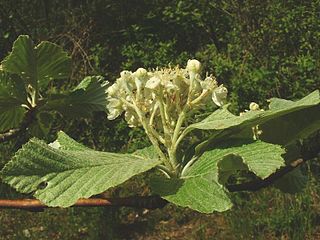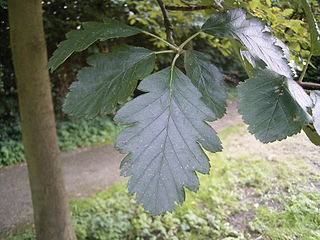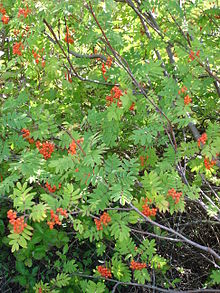
Rosaceae, the rose family, is a medium-sized family of flowering plants that includes 4,828 known species in 91 genera.

The MaloideaeC.Weber was the apple subfamily, a grouping used by some taxonomists within the rose family, Rosaceae. Recent molecular phylogenetic evidence has shown that the traditional Spiraeoideae and Amygdaloideae form part of the same clade as the traditional Maloideae, and the correct name for this group is Amygdaloideae. Earlier circumscriptions of Maloideae are more-or-less equivalent to subtribe Malinae or to tribe Maleae. The group includes a number of plants bearing commercially important fruits, such as apples and pears, while others are cultivated as ornamentals.

Amygdaloideae is a subfamily within the flowering plant family Rosaceae. It was formerly considered by some authors to be separate from Rosaceae, and the family names Prunaceae and Amygdalaceae have been used. Reanalysis from 2007 has shown that the previous definition of subfamily Spiraeoideae was paraphyletic. To solve this problem, a larger subfamily was defined that includes the former Amygdaloideae, Spiraeoideae, and Maloideae. This subfamily, however, is to be called Amygdaloideae rather than Spiraeoideae under the International Code of Nomenclature for algae, fungi, and plants as updated in 2011.

The rowans or mountain-ashes are shrubs or trees in the genus Sorbus of the rose family, Rosaceae. They are native throughout the cool temperate regions of the Northern Hemisphere, with the highest species diversity in the Himalaya, southern Tibet and parts of western China, where numerous apomictic microspecies occur. The name rowan was originally applied to the species Sorbus aucuparia and is also used for other species in the genus Sorbus.

The whitebeams are members of the family Rosaceae, comprising the genus Aria. They are deciduous trees with simple or lobed leaves, arranged alternately. They are related to the rowans, and many of the endemic restricted-range apomictic microspecies of whitebeam in Europe are thought to derive from hybrids between the common whitebeam and the European rowan. Some are also thought to be hybrids with the wild service tree, and the service tree of Fontainebleau found in French woodlands.

Chamaemespilus is a genus of shrubs in the family Rosaceae. It is monotypic, being represented by the single species Chamaemespilus alpina, commonly known as false medlar or dwarf whitebeam. It is native to the mountains of central and southern Europe, from the Pyrenees east through the Alps to the Carpathians and the Balkans, growing at elevations of up to 2500 m.
The Arran whitebeams are species of whitebeam endemic to the island of Arran, Ayrshire, Scotland.

Hedlundia arranensis, sometimes referred to as the Scottish or Arran whitebeam, is a species of plant in the family Rosaceae. It is endemic to the island of Arran in Scotland.

Aria edulis, the whitebeam or common whitebeam, is a species of deciduous tree in the family Rosaceae. It is native to most of Europe as well as North Africa and temperate Asia. Typically compact and domed, with few upswept branches and almost-white underside of the leaves, it generally favours dry limestone and chalk soils. The hermaphrodite cream-white flowers appear in May, are insect pollinated, and go on to produce scarlet berries, which are often eaten by birds.

Scandosorbus intermedia or, formerly, Sorbus intermedia, the Swedish whitebeam, is a species of whitebeam found in southern Sweden, with scattered occurrences in Estonia, Latvia, easternmost Denmark (Bornholm), the far southwest of Finland, and northern Poland.

Hedlundia hybrida, the Swedish service-treeFinnish whitebeam, or oakleaf mountain ash, is a species of whitebeam native to Norway, eastern Sweden, south-western Finland, and locally in Latvia.

Alniaria alnifolia, also called alder-leafed whitebeam, Korean whitebeam, or Korean mountain ash, Korean: 팥배나무; RR: Patbaenamu; MR: p'atpaenamu; lit. 'red bean pear tree' Chinese: 水榆花楸; pinyin: shui yu hua qiu; lit. 'water elm rowan', is a species of whitebeam native to eastern Asia in eastern and northern China, Taiwan, Korea and Japan.

Sorbus minima, commonly known as the lesser whitebeam or least whitebeam, is a shrub belonging to the subgenus Aria (whitebeams) in the genus Sorbus. It is endemic to Wales where it grows at a few sites in Breconshire. It is an apomictic microspecies which reproduces asexually and so is reproductively isolated from its close relatives such as the Swedish whitebeam, S. intermedia. It probably originated as a hybrid between the rock whitebeam and the rowan. It was first discovered in 1893 by Augustin Ley, the vicar of Sellack in Herefordshire who travelled widely in Wales.

Sorbus vilmorinii, the Vilmorin's rowan or Vilmorin's mountain ash, is a species of flowering plant in the family Rosaceae, native to Sichuan, Tibet and Yunnan in China.

The Maleae are the apple tribe in the rose family, Rosaceae. The group includes a number of plants bearing commercially important fruits, such as apples and pears, while others are cultivated as ornamentals. Older taxonomies separated some of this group as tribe Crataegeae, as the Cydonia group, or some genera were placed in family Quillajaceae.

Malinae is the name for the apple subtribe in the rose family, Rosaceae. This name is required by the International Code of Nomenclature for algae, fungi, and plants, which came into force in 2011 for any group at the subtribe rank that includes the genus Malus but not either of the genera Rosa or Amygdalus. The group includes a number of plants bearing commercially important fruits, such as apples and pears, while others are cultivated as ornamentals.

Torminalis is a genus of plants in the rose family Rosaceae. The genus Torminalis was formerly included within the genus Sorbus, as the section Torminaria, but the simple-leafed species traditionally classified in Sorbus are now considered to form a separate monophyletic group. It is monotypic, being represented by the single species, Torminalis glaberrima, commonly known as wild service tree, chequers, and checker tree. This tree is native to Europe, parts of northern Africa and western Asia.
Aria leighensis, commonly known as Leigh Woods whitebeam, is a rare species of whitebeam, a flowering plant in the|rose family Rosaceae.

Hedlundia is a genus of plants in the rose family. They are shrubs or small trees that have a hybrid origin involving crosses between Aria and Sorbus sensu stricto. There are about 48 species are distributed across central, western and southern Europe, Scandinavia, Turkey, the Caucasus, Crimea, and also central Asia. The term Hedlundia was published in 2017.



















